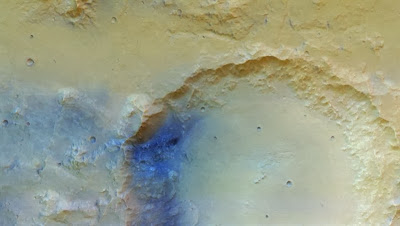The Automated Transfer Vehicle (ATV) "Georges Lemaitre" has begun pre-flight checkout in the Spaceport's clean room facilities, following its arrival in French Guiana for a scheduled Ariane 5 flight next year.
As the fifth and final ATV to be launched by Arianespace under current arrangements with the European Space Agency, this spacecraft's Integrated Cargo Carrier (ICC) has now been removed from its special shipping container in the S5C preparation hall.
The ICC makes up 60 percent of the Automated Transfer Vehicle's total volume, with the capacity of ferrying up to 6.6 metric tons of cargo - both dry and fluid - on the spacecraft's servicing mission to the International Space Station (ISS).
Incorporating a two-part design, the Integrated Cargo Carrier includes a pressurized module for docking to the space station, where all dry materials are contained.
Up to two ISS astronauts can access this section while the spacecraft is attached to the orbital facility, working to unload supplies or conduct experiments.
Fluid cargo - such as propellant for refueling of the International Space Station - is stored in the ICC's non-pressurized area and transferred to the space station through pipes or manually operated hoses.
Prior to Georges Lemaitre's ESA-targeted launch date in 2014, final assembly of the spacecraft will be carried out at the Spaceport, including the Integrated Cargo Carrier, the Service Module solar panels and the Separation and Distancing Module (SDM) that links the ATV to its Ariane 5 vehicle.
Designated Georges Lemaitre after the Belgian physicist and father of the Big Bang theory, the fifth Automated Transfer Vehicle will resupply the International Space Station, as well as perform maneuvers to maintain this manned facility's nominal orbit.
An Astrium-led industry consortium is responsible for producing this series of resupply spacecraft under the European Space Agency-managed program.
To date all four Automated Transfer Vehicles have been orbited by Ariane 5 ES launchers, beginning with "Jules Verne" in March 2008, which was followed by "Johannes Kepler" in February 2011, "Edoardo Amaldi" in March 2012, and this June's flight with "Albert Einstein."
As the fifth and final ATV to be launched by Arianespace under current arrangements with the European Space Agency, this spacecraft's Integrated Cargo Carrier (ICC) has now been removed from its special shipping container in the S5C preparation hall.
The ICC makes up 60 percent of the Automated Transfer Vehicle's total volume, with the capacity of ferrying up to 6.6 metric tons of cargo - both dry and fluid - on the spacecraft's servicing mission to the International Space Station (ISS).
Incorporating a two-part design, the Integrated Cargo Carrier includes a pressurized module for docking to the space station, where all dry materials are contained.
Up to two ISS astronauts can access this section while the spacecraft is attached to the orbital facility, working to unload supplies or conduct experiments.
Fluid cargo - such as propellant for refueling of the International Space Station - is stored in the ICC's non-pressurized area and transferred to the space station through pipes or manually operated hoses.
Prior to Georges Lemaitre's ESA-targeted launch date in 2014, final assembly of the spacecraft will be carried out at the Spaceport, including the Integrated Cargo Carrier, the Service Module solar panels and the Separation and Distancing Module (SDM) that links the ATV to its Ariane 5 vehicle.
Designated Georges Lemaitre after the Belgian physicist and father of the Big Bang theory, the fifth Automated Transfer Vehicle will resupply the International Space Station, as well as perform maneuvers to maintain this manned facility's nominal orbit.
An Astrium-led industry consortium is responsible for producing this series of resupply spacecraft under the European Space Agency-managed program.
To date all four Automated Transfer Vehicles have been orbited by Ariane 5 ES launchers, beginning with "Jules Verne" in March 2008, which was followed by "Johannes Kepler" in February 2011, "Edoardo Amaldi" in March 2012, and this June's flight with "Albert Einstein."




















